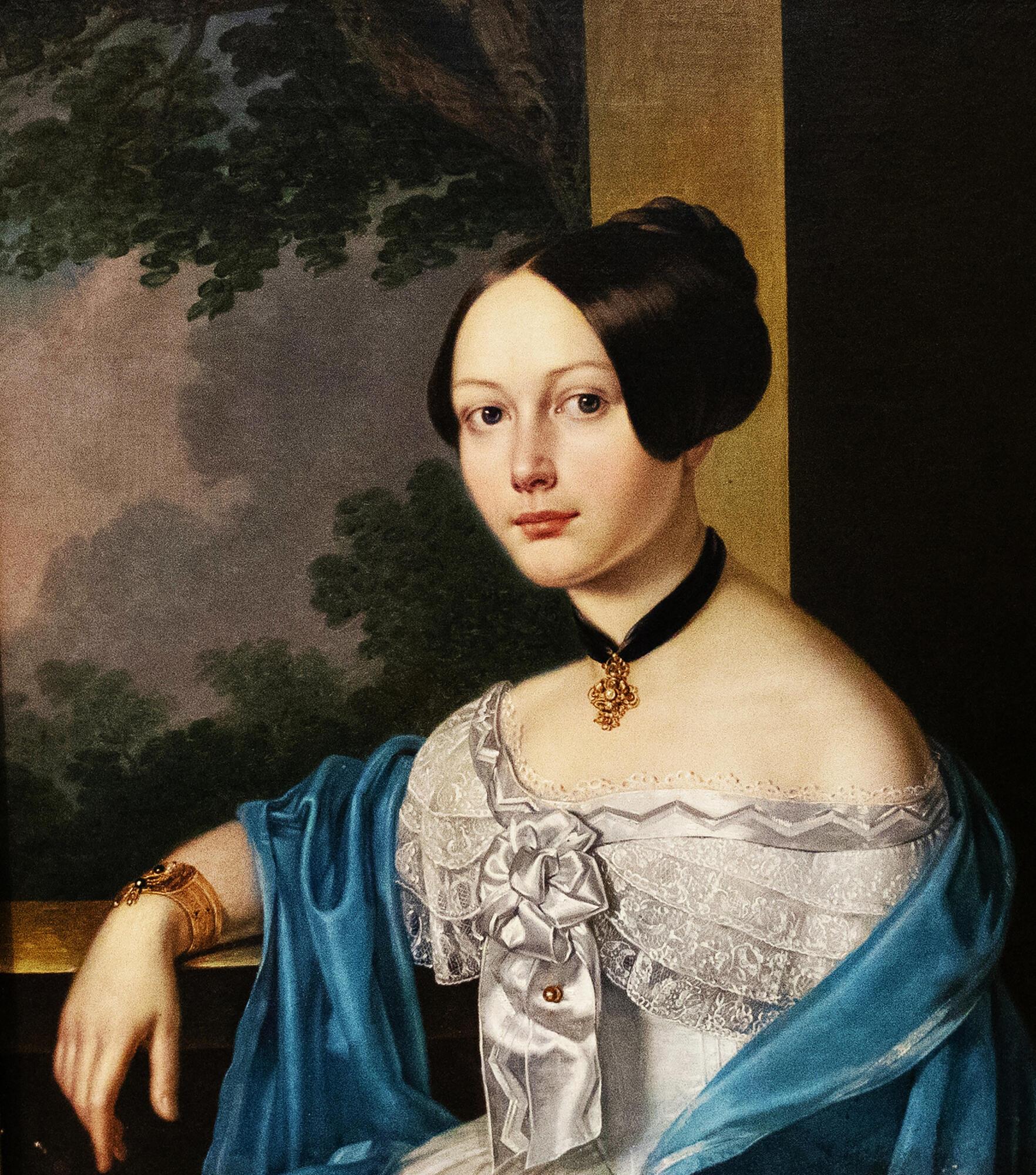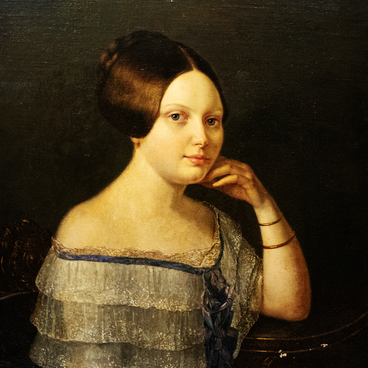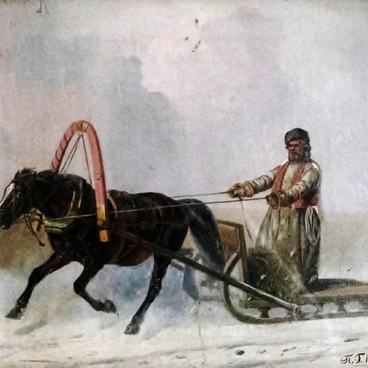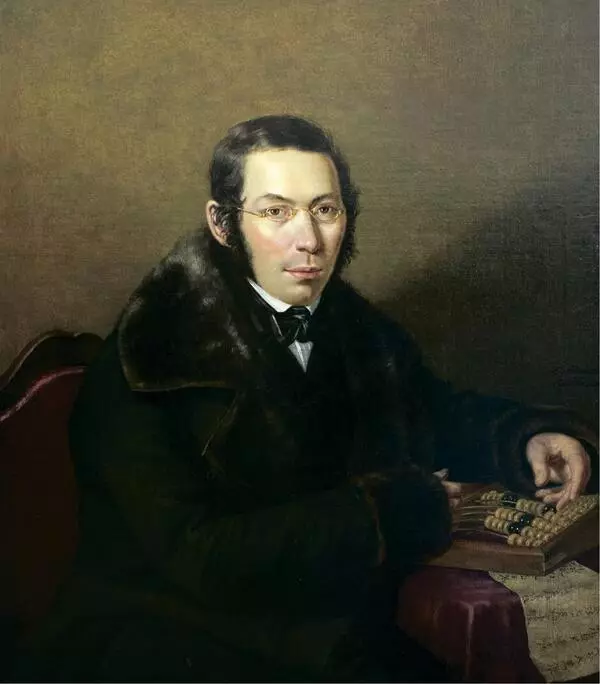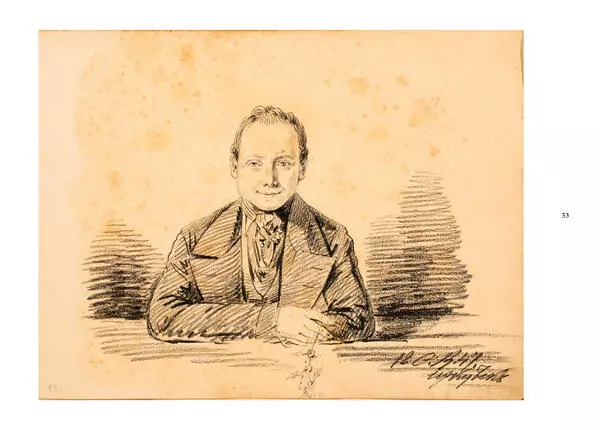In the painting, MarIa Alexandrovna Talyzina is seated in a relaxed pose against a landscape background, with her body half-turned to the viewer. The combination of bright saturated colors of her clothes and green foliage gives the portrait vibrancy and expressiveness.
The author of the painting, Carl Yakovlevich Reichel, managed to convey the soft femininity of his very young model. The sparkle of her eyes, the faint smile, and the delicate face with a slight blush hint at the inner excitement and childish naivety of the portrait’s subject. The porcelain quality of her skin and the roundness of the shoulders are further emphasized by a light-colored low-cut satin dress decorated with thin lace and a bow on the chest, a blue moire shawl falling in soft folds onto her arm, and dark hair fashioned in a characteristic style of that time.
Carl Yakovlevich (Christian Philipp) Reichel (1788–1857) was a painter and engraver. He was born in Warsaw, the son of a medalist (a person who fabricates molds for casting and minting coins and medals) Yakov Reichel.
In 1801, Carl Yakovlevich was admitted to the Academy of Arts in St. Petersburg. He was awarded the 2nd gold medal in the program “Portray a Sculptor Practicing His Work”, and the first gold medal in the program “Portray a Priest Explaining the Commandments to Two Young People.” Upon graduation from the Academy of Arts, Reichel received a first-degree certificate and a honorary sword.
In 1810, the Academy of Arts granted Reichel a pension. The artist used this money to travel abroad and visit Paris and Rome. A year later, he returned to St. Petersburg, where he became a famous portrait artist soon after.
He painted portraits of the poet Pyotr Vyazemsky, musician Mikhail Vielgorsky, artist Fyodor Tolstoy, as well as numerous portraits of members of the St. Petersburg nobility.
In 1819, Reichel left Russia and did not return for many years. Only two decades later did he turn up in Novgorod at the house of his brother Kazimir, who was a railway engineer. While in Novgorod, he met Alexander Herzen; he went on to portray Herzen’s wife in two of his pencil drawing and a painting.
Carl Yakovlevich was married to Sophia Alexeyevna Yushnevskaya, daughter of the Decembrist Alexey Yushnevsky. From 1845 to 1857, Reichel’s family lived in Irkutsk, while he himself went to work in Kyakhta. In Irkutsk, Reichel painted portraits: in particular, in 1846, he made a portrait of Empress Alexandra Fyodorovna (wife of Nicholas I) for the Maiden Institute of Eastern Siberia.
It is also known that Reichel painted companion portraits of the Decembrist Sergey Trubetskoy and his wife in 1854. In June 1857, Reichel left Siberia and traveled to Kiev with his daughter Sophia to visit his mother-in-law, wife, and son. From there, this time alone, the artist went to the town of Tulchin in the Bratslav District of the Podolsk Province, where he died at the end of that same year.
The author of the painting, Carl Yakovlevich Reichel, managed to convey the soft femininity of his very young model. The sparkle of her eyes, the faint smile, and the delicate face with a slight blush hint at the inner excitement and childish naivety of the portrait’s subject. The porcelain quality of her skin and the roundness of the shoulders are further emphasized by a light-colored low-cut satin dress decorated with thin lace and a bow on the chest, a blue moire shawl falling in soft folds onto her arm, and dark hair fashioned in a characteristic style of that time.
Carl Yakovlevich (Christian Philipp) Reichel (1788–1857) was a painter and engraver. He was born in Warsaw, the son of a medalist (a person who fabricates molds for casting and minting coins and medals) Yakov Reichel.
In 1801, Carl Yakovlevich was admitted to the Academy of Arts in St. Petersburg. He was awarded the 2nd gold medal in the program “Portray a Sculptor Practicing His Work”, and the first gold medal in the program “Portray a Priest Explaining the Commandments to Two Young People.” Upon graduation from the Academy of Arts, Reichel received a first-degree certificate and a honorary sword.
In 1810, the Academy of Arts granted Reichel a pension. The artist used this money to travel abroad and visit Paris and Rome. A year later, he returned to St. Petersburg, where he became a famous portrait artist soon after.
He painted portraits of the poet Pyotr Vyazemsky, musician Mikhail Vielgorsky, artist Fyodor Tolstoy, as well as numerous portraits of members of the St. Petersburg nobility.
In 1819, Reichel left Russia and did not return for many years. Only two decades later did he turn up in Novgorod at the house of his brother Kazimir, who was a railway engineer. While in Novgorod, he met Alexander Herzen; he went on to portray Herzen’s wife in two of his pencil drawing and a painting.
Carl Yakovlevich was married to Sophia Alexeyevna Yushnevskaya, daughter of the Decembrist Alexey Yushnevsky. From 1845 to 1857, Reichel’s family lived in Irkutsk, while he himself went to work in Kyakhta. In Irkutsk, Reichel painted portraits: in particular, in 1846, he made a portrait of Empress Alexandra Fyodorovna (wife of Nicholas I) for the Maiden Institute of Eastern Siberia.
It is also known that Reichel painted companion portraits of the Decembrist Sergey Trubetskoy and his wife in 1854. In June 1857, Reichel left Siberia and traveled to Kiev with his daughter Sophia to visit his mother-in-law, wife, and son. From there, this time alone, the artist went to the town of Tulchin in the Bratslav District of the Podolsk Province, where he died at the end of that same year.
